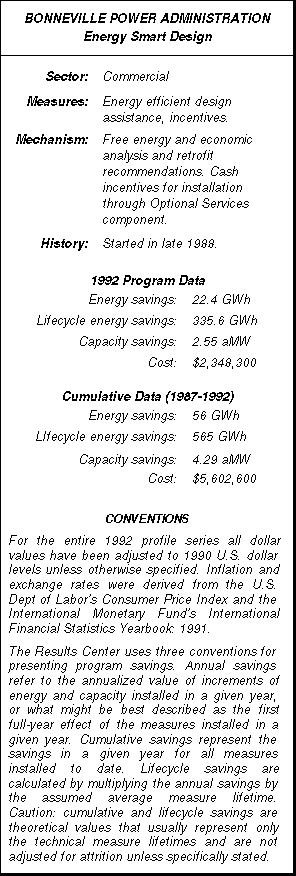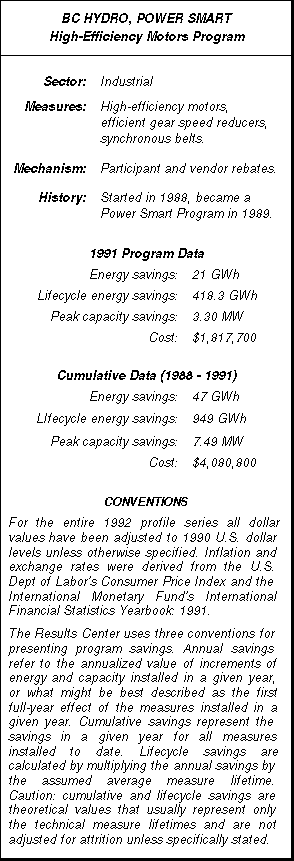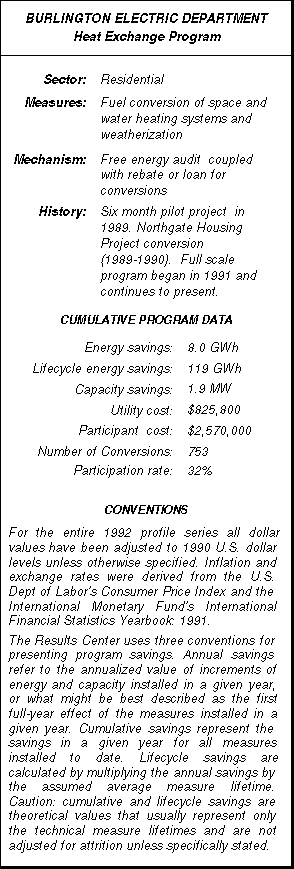EXECUTIVE SUMMARY
 Bonneville Power Administration’s Energy Smart Design (ESD) provides design assistance and incentives for installation of energy efficiency measures in new and existing commercial buildings. Perhaps the most exciting aspect of ESD is its dynamic evolution from a somewhat limited program to a comprehensive system for promoting and garnering energy savings. This profile aims to capture the progress made by BPA in adapting program parameters to maximize the effectiveness of ESD.
Bonneville Power Administration’s Energy Smart Design (ESD) provides design assistance and incentives for installation of energy efficiency measures in new and existing commercial buildings. Perhaps the most exciting aspect of ESD is its dynamic evolution from a somewhat limited program to a comprehensive system for promoting and garnering energy savings. This profile aims to capture the progress made by BPA in adapting program parameters to maximize the effectiveness of ESD.
ESD began in 1988 strictly as a design assistance program. BPA’s evaluations identified the need to incorporate financial incentives into the program to increase the uptake of measures identified through design assistance. Therefore, an Optional Services (OS) component was added in 1990 to provide rebates. In October, 1992, a second evolution of the program took place and what BPA calls the "Long Term ESD" program began.
ESD’s mechanism for customer participation is simple. A scoping meeting is held to review the project and explore design alternatives. The utility team and client agree on a list of measures to be examined to determine their effectiveness. Measures are analyzed using modelling, or less complex procedures such as manual calculations, or selection from a rebate list or a prescriptive path manual. Note that the client is not required to accept any of the recommended measures.
The range of conservation measures analyzed for any ESD project is a function of the building type and size. It is common to examine alternate HVAC systems, more efficient lighting, the use of more efficient glazings, as well as building shell thermal improvements. In some cases, such as restaurants and laundries, less common measures such as heat recovery systems are analyzed. Eligibility for rebates under OS is determined and the client may proceed with installation of recommended energy conservation measures and receive incentives.
Savings attributable to ESD were quite small in the first years of the program but with the implementation of OS, savings increased significantly. After just two quarters of the fiscal year 1991-92, estimated annual savings nearly doubled to 22.4 GWh. Through March 31, 1992, projects completed under ESD accumulated 37.6 GWh in annual energy savings and 4.29 aMW in annual demand savings.[R#18]
BPA has spent a total of $5.6 million on ESD since the program’s inception. Even though OS was not implemented until 1991, the total expenditures on OS incentives, at $2.6 million, has already exceeded BPA expenditures on design assistance services, at $2.4 million. At a 5% discount rate, the cost of saved energy for ESD in the first half of the 1991-92 fiscal year was a very respectable 1.36 ¢/kWh.
[CLICK HERE TO DOWNLOAD THE ENTIRE 21 PAGE PROFILE IN PDF FILE FORMAT]
This profile was produced by 

 Each year over 300,000 horsepower (HP) of 3-phase integral electric motors are purchased by British Columbia Hydro (BCH) customers, including standard and high-efficiency motors. The goal of the High-Efficiency Motors Program has been to transform the market in the province and to make sure that most if not all of these motor sales are high-efficiency motors. Given the low electricity costs in British Columbia, many B.C. Hydro customers have opted to pay the low initial costs of standard efficiency motors despite the lifecycle benefits of high-efficiency motors. Overcoming this barrier, has been the essence of the High-Efficiency Motors Program.
Each year over 300,000 horsepower (HP) of 3-phase integral electric motors are purchased by British Columbia Hydro (BCH) customers, including standard and high-efficiency motors. The goal of the High-Efficiency Motors Program has been to transform the market in the province and to make sure that most if not all of these motor sales are high-efficiency motors. Given the low electricity costs in British Columbia, many B.C. Hydro customers have opted to pay the low initial costs of standard efficiency motors despite the lifecycle benefits of high-efficiency motors. Overcoming this barrier, has been the essence of the High-Efficiency Motors Program. Burlington Electric Department (BED) is currently engaged in the pioneering DSM practice of promoting the cost effective substitution of alternate fuels for electricity. Three discrete BED projects are presented in this profile as the Heat Exchange Program. The program includes 1) a DOE pilot fuel switching program that resulted in the conversions of 44 residences to natural gas space heating using direct vent gas-fired space heaters; 2) a fuel switching project at the Northgate Housing complex that resulted in conversions of 336 units ; and 3) the full-scale fuel switching program that is currently active in Burlington.
Burlington Electric Department (BED) is currently engaged in the pioneering DSM practice of promoting the cost effective substitution of alternate fuels for electricity. Three discrete BED projects are presented in this profile as the Heat Exchange Program. The program includes 1) a DOE pilot fuel switching program that resulted in the conversions of 44 residences to natural gas space heating using direct vent gas-fired space heaters; 2) a fuel switching project at the Northgate Housing complex that resulted in conversions of 336 units ; and 3) the full-scale fuel switching program that is currently active in Burlington. The Western Area Power Administration (Western) Pump Testing and Irrigation Efficiency program promotes state-of-the-art methods for improving irrigation pump efficiency by providing pump tests and recommending efficiency improvements. The educational component of the program is perhaps its strongest, as WAPA provides irrigation efficiency analyses and recommends appropriate techniques for reducing the amount of water that must be pumped, and thus the demands upon the irrigation pumps, while still providing crops with sufficient water.
The Western Area Power Administration (Western) Pump Testing and Irrigation Efficiency program promotes state-of-the-art methods for improving irrigation pump efficiency by providing pump tests and recommending efficiency improvements. The educational component of the program is perhaps its strongest, as WAPA provides irrigation efficiency analyses and recommends appropriate techniques for reducing the amount of water that must be pumped, and thus the demands upon the irrigation pumps, while still providing crops with sufficient water.